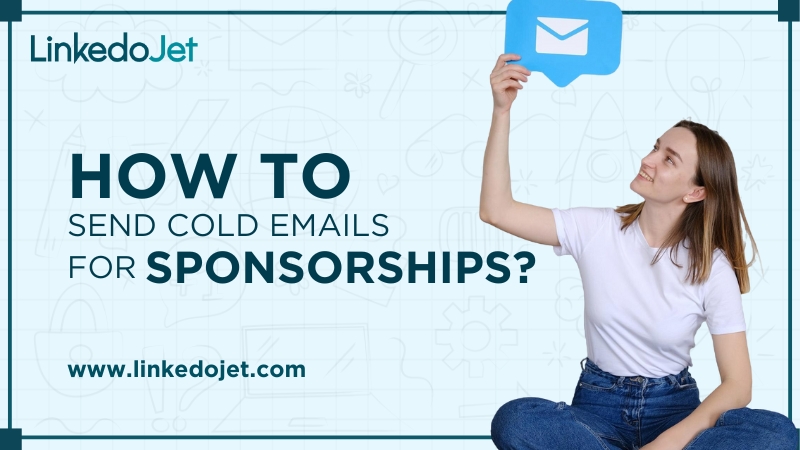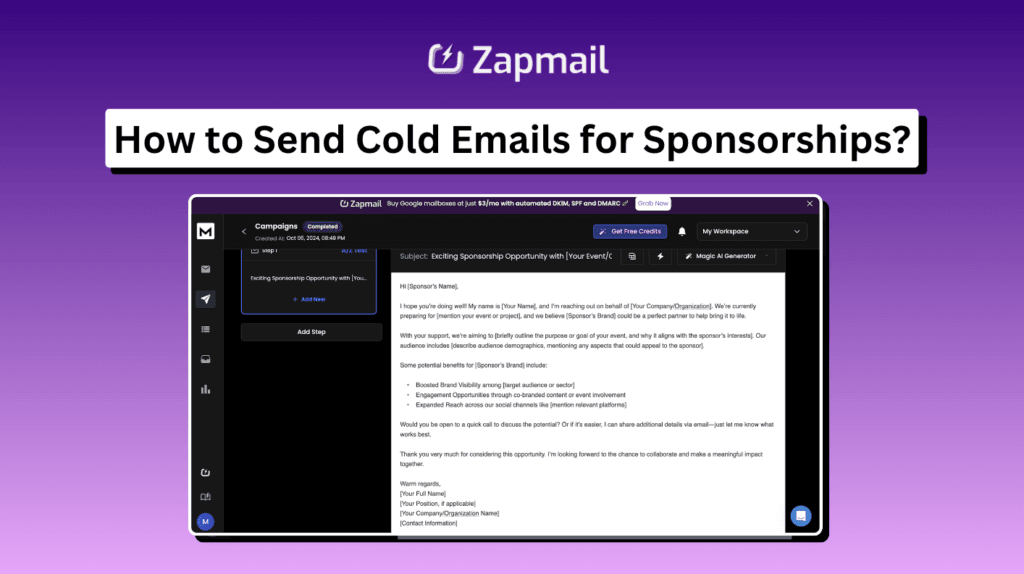Sending cold emails for sponsorships can be challenging but rewarding. You need to stand out and make a strong impression quickly.
Securing sponsorships through cold emails requires a strategic approach. You can’t just send any email and expect a positive response. You must craft a message that grabs attention and delivers value. In this blog post, we’ll guide you through the essential steps to create effective cold emails for sponsorships.
From understanding your potential sponsor to writing a compelling email, we will cover everything you need. This way, you can increase your chances of getting the sponsorships you seek. Ready to learn how to send cold emails that work? Let’s get started!
Credit: blog.hubspot.com
Crafting The Perfect Subject Line
Sending cold emails for sponsorships can be challenging. One key factor to success is crafting the perfect subject line. A well-crafted subject line grabs attention and encourages the recipient to open the email. Let’s explore two essential strategies to create the perfect subject line.
Keeping It Short And Sweet
Short subject lines work best. They are easy to read and understand. Aim for six to eight words. This length fits well on mobile screens. Avoid complex words. Simple language is more effective. Make every word count.
Clear and concise is the goal. Too much information can overwhelm. A brief subject line sparks curiosity. It leaves the recipient wanting to know more. This increases the chances of your email being opened.
Using Personalization
Personalization makes your email stand out. Use the recipient’s name. People respond better to their own name. It feels more personal and less like spam. Mention something relevant to them. This shows you did your research.
Personalization can be as simple as referencing their company. Highlight a recent achievement or project. This makes your email feel tailored. It shows you value their time and effort. Personal touches build a connection. They increase the likelihood of a positive response.
Writing An Engaging Opening
Writing an engaging opening is crucial for sending cold emails for sponsorships. The first few sentences determine if your email will be read or ignored. Let’s dive into some effective strategies to grab attention and build a connection with your recipients.
Grabbing Attention Immediately
The opening line should catch the recipient’s eye right away. Use a powerful, concise statement or question. Here are some examples:
- State a surprising fact: “Did you know that 70% of startups fail due to lack of funding?”
- Ask a relevant question: “Looking to expand your brand’s reach in 2024?”
- Offer a unique insight: “We have identified a new market that aligns perfectly with your brand.”
Keep your sentences short and impactful. Avoid jargon. Make the recipient curious to read further.
Building A Connection
After grabbing attention, build a connection. Personalize your email to show you’ve done your research. Mention a recent achievement or project of the recipient:
“I saw your recent collaboration with [Brand Name]. It was inspiring.”
Highlight common interests or goals. This makes your email feel more genuine. For example:
- “Both our brands are committed to sustainability.”
- “We share a passion for community engagement.”
Show that you understand their values and how you can add value. This fosters trust and increases the chances of a positive response.
Presenting Your Value Proposition
Sending cold emails for sponsorships can be daunting. The key is to present your value proposition effectively. This section will help you understand how to showcase what you bring to the table. Doing so can grab the sponsor’s attention and spark their interest.
Highlighting Mutual Benefits
When asking for sponsorship, you should highlight mutual benefits. Clearly explain how the sponsor will benefit from partnering with you. Here are some points to consider:
- Increased brand exposure: Explain how you can help them reach a wider audience.
- Targeted marketing: Show that your audience matches their target market.
- Positive association: Mention the value of being associated with your brand.
Show them that the partnership is a win-win situation.
Being Clear And Concise
Your email should be clear and concise. Avoid long, complicated sentences. Use short paragraphs and bullet points. For example:
- Introduce yourself and your project.
- State your purpose for reaching out.
- Present your value proposition with specific benefits.
- Call to action: Request a meeting or a call.
By keeping your email short and to the point, you respect the recipient’s time.
Including Social Proof
Including social proof in your cold emails for sponsorships can make a big difference. Social proof builds credibility and trust with potential sponsors. It shows that others have already benefited from working with you. This makes your proposal more appealing and trustworthy.
Sharing Success Stories
Success stories highlight the positive impact of past sponsorships. Share specific examples of how previous sponsors benefited from their partnership with you. Mention any measurable results like increased brand visibility or sales. These stories show potential sponsors what they can achieve by working with you.
Using Testimonials
Testimonials from past sponsors add a personal touch to your email. They provide authentic, firsthand accounts of your collaboration. Include quotes from satisfied sponsors who can vouch for your professionalism and effectiveness. This can reassure potential sponsors about your reliability and the value of your partnership.
Creating A Strong Call To Action
Sending cold emails for sponsorships can be daunting. One crucial element is your Call to Action (CTA). A strong CTA compels the reader to take action. It should be direct, specific, and offer flexibility to the recipient.
Being Direct And Specific
A direct and specific CTA leaves no room for confusion. Clearly state what you want from the sponsor. For example, instead of saying, “Please consider sponsoring our event,” say, “We would appreciate your sponsorship for our annual tech conference on June 15.”
Using direct language shows confidence. It also respects the recipient’s time. They know exactly what you are asking for and what steps to take next.
Offering Flexible Options
Offering flexible options in your CTA can increase your chances of a positive response. You can provide different levels of sponsorship to cater to various budgets.
| Sponsorship Level | Benefits |
|---|---|
| Gold | Logo on all materials, 5 VIP tickets |
| Silver | Logo on website, 2 VIP tickets |
| Bronze | Logo on event banner, 1 VIP ticket |
This approach makes it easier for the sponsor to say yes. They can choose a level that fits their needs and budget. It also shows that you are considerate of their constraints.
Personalizing Each Email
Personalizing each email is crucial for securing sponsorships. A generic message lacks impact. A tailored approach shows effort and interest. It increases the chances of a positive response. Here’s how you can personalize each email effectively.
Researching The Recipient
Understand who you are emailing. Research the recipient thoroughly. Learn about their role and company. Check their LinkedIn profile. Find any common interests or connections. This information will help you craft a more relevant email.
Tailoring Your Message
Tailor your message to the recipient’s needs. Use their name in the greeting. Mention something specific about their work. Explain why your proposal benefits them. Show that you have done your homework. This makes your email stand out.
Following Up Effectively
Following up effectively is key to securing sponsorships through cold emails. A well-timed and polite follow-up can make a big difference. It shows your persistence and interest without coming across as pushy.
Timing Your Follow-ups
Timing your follow-ups is crucial. Wait three to seven days before sending a follow-up email. This gives the recipient enough time to consider your initial email. If you don’t hear back, send another follow-up after another week.
Avoid sending follow-ups too frequently. This can annoy the recipient. Space out your emails to maintain a professional image. Follow-ups should be timely but not overwhelming.
Crafting Polite Reminders
Crafting polite reminders is an art. Start with a friendly greeting. Mention your previous email and your request for sponsorship. Keep it short and to the point.
Be respectful of their time. Acknowledge they might be busy. Express your continued interest in working with them. End with a polite sign-off.
Polite reminders show you are serious and respectful. They can prompt a response, even if it is a no. This helps you move on or adjust your approach.

Credit: blog.linkedojet.com
Avoiding Common Mistakes
Sending cold emails for sponsorships can be tricky. Many make common mistakes that reduce their chances of success. Avoiding these errors increases your chances of getting the sponsorship you need.
Avoiding Spammy Language
Avoid language that sounds spammy. Words like “free,” “guaranteed,” or “limited time” can trigger spam filters. Also, these words can make your email look unprofessional. Aim for a natural and friendly tone.
Keep your message clear and to the point. Don’t use too many exclamation points. One or two is enough. Overuse of punctuation looks desperate. Be genuine in your approach. Sponsors appreciate honesty and clarity.
Proofreading Carefully
Proofread your email carefully. Spelling and grammar mistakes can make you look careless. Use tools like Grammarly or Hemingway to check your text. Read your email out loud. This helps catch errors you might miss when reading silently.
Ask a friend to review your email. A fresh set of eyes can spot mistakes you missed. Ensure your email is easy to understand. Avoid long sentences and complex words. Keep it simple and clear.

Credit: swipefile.com
Frequently Asked Questions
What Is A Cold Email For Sponsorship?
A cold email for sponsorship is an unsolicited email sent to potential sponsors. The email aims to introduce yourself, explain your project, and seek support.
How To write an effective cold email?
To write an effective cold email, keep it concise and personalized. Address the recipient by name, explain your project, and state how it benefits them.
What Should Be The Subject Line Of A Cold Email?
The subject line should be catchy and relevant. Examples include “Exciting Sponsorship Opportunity” or “Partner with Us for Mutual Growth. “
How Long Should A Cold Email Be?
A cold email should be short and to the point. Ideally, it should be around 100-150 words, focusing on key points.
Conclusion
Crafting effective cold emails for sponsorships is an essential skill. Start with a clear goal and a personal touch. Keep your message concise and to the point. Always follow up, but don’t be too pushy. Over time, you’ll develop a strategy that works best for you.
Practice makes perfect. Remember, patience and persistence are key. With the right approach, securing sponsorships will become easier. Happy emailing!
